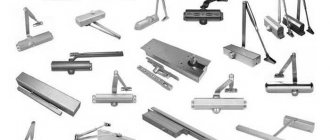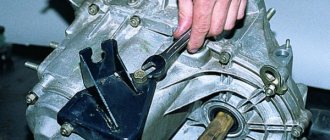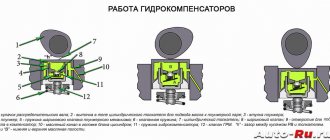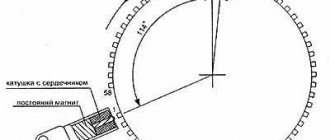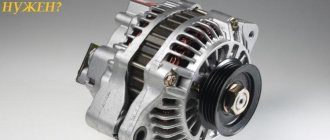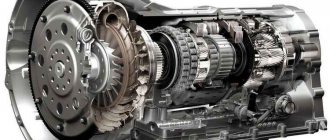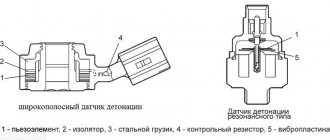Many cars with powerful turbine engines contain in their design an unusual part - an intercooler. What is it in a car, how does the part work and work, and how to handle the repair yourself - these are the questions that owners of modern cars are increasingly asking.
The intercooler is a technically unique part of a turbocharged engine, thanks to which the car receives an additional 15-20 horsepower without dangerous consequences. If problems arise, repairs must be made immediately, otherwise the engine turbine will begin to lose power, and over time the power unit will fail.
Diagram of the part and its location in the engine
Externally, the intercooler resembles a radiator consisting of plates and pipes. In order to additionally cool the air, copper or aluminum plates are welded to the tubes.
Externally, the intercooler is not much different from the radiator
In the engine, the part is mounted between the intake manifold and the turbine compressor. It is mounted in the front part of the engine below the radiator, or above the engine. In some car models, the intercooler is located in the wings.
Characteristic
You may be interested in:Patron Sport 200: technical specifications and price
So, what is an intercooler in a diesel car? This is an intermediate radiator, which is located in the air supply system to the internal combustion engine cylinders. Why do you need an intercooler on a diesel engine? The main task of this element is to cool the air. It is worth noting that this radiator is installed not only on diesel cars. You can also find them on gasoline cars, but this only applies to sports cars that are equipped with a powerful turbine. And the installation of an intercooler on a diesel engine is often done at the factory. Yes, these radiators are somewhat smaller than those on cars with gasoline turbo engines, but the compressor itself is less efficient.
The principle of operation of the intercooler and its effect on engine power
The increase in power occurs due to the ability of the intercooler to reduce the air temperature to 55-60 degrees. This improves the quality of air entering the turbocharger, which contributes to better filling of the cylinders and increased engine performance.
The technology is 100% justified, since reducing the air temperature by just 10 degrees gives the engine 3 to 5 percent more power. The absence of an intercooler or its malfunction leads to excessive, sometimes up to 200 degrees, heating of the air sucked in by the turbine. This in turn reduces the power of the motor, and subsequently can lead to its breakdown.
The operation of the intercooler affects fuel consumption. The combustible mixture burns more efficiently, which means the required amount of gasoline is also reduced. The efficiency of a part is measured by the reduction in engine temperature compared to ambient air temperature. Additionally, the intercooler reduces the boost pressure thanks to the resistance created by this part. For a good intercooler, a pressure drop of 1-2 psi can be considered acceptable.
What is an intercooler
Changing the oil in the Haldex coupling on a Tiguan
As is known, forced air charging under pressure allows you to burn more fuel and achieve a significant increase in internal combustion engine power without increasing the physical volume of the cylinders. This solution is widely used on almost all modern diesel engines, and is also used in the design of forced gasoline units.
The intercooler is a component element that is included in the overall turbocharging scheme. The fact is that the air is strongly compressed by a turbocharger, as a result of which it heats up. If heated air is immediately supplied to the cylinders, then its volume will not be enough for efficient and complete combustion of a portion of the fuel. Engine power decreases, fuel consumption also increases noticeably.
Types of intercoolers
Depending on the design and operating principles, intercoolers are divided into two types:
Air
An intercooler of simple design consists of a series of tubes connected to each other by rows of plates. In fact, the purpose of the part is to pass air coming from outside through the tubes. The plates make it possible to increase the heat transfer area, and due to this, the air has time to cool before it enters the turbine.
An air intercooler allows you to reduce the temperature of the air supplied to the turbine by 40-50 degrees, which gives a 12 to 15% increase in engine power. The performance of the part can only be assessed at speeds above 30-40 km/h.
An air intercooler, also known as an air-to-air intercooler, uses a stream of advancing air as the coolant.
Air models are installed in three places:
- Under the hood, directly above the engine.
- Behind the front bumper.
- In the side spaces of the wings.
The second and third installation options are more expedient and are more common, since they provide intense airflow. An air intercooler is most often installed on SUVs and trucks.
The disadvantages of air models are their large mass and impressive size.
Water
It uses water as a coolant, which copes with the task much more efficiently. The water intercooler is more compact and does not take up much space under the hood of the car. Although when installing it you have to find space for the pump and temperature sensor. But the efficiency of this type of part is several times higher.
On average, a water intercooler lowers the temperature by 60-70 degrees. In more advanced and expensive models, a refrigerant liquid acts as a coolant: antifreeze, antifreeze, liquid nitrogen. Due to the properties of such coolants, heat transfer doubles compared to models running on water.
Liquid absorbs heat much more intensely, which is why water-to-air intercoolers are much more efficient than their air-based counterparts
However, this type of part also has some disadvantages. The water model has a more complex design. The operation of the part is controlled by a water pump, a temperature sensor and a control unit. This leads to an increase in the cost of the structure and the complexity of repair in the event of a breakdown. Therefore, models in the lower price range mainly use air intercoolers. In addition, this device requires systematic monitoring of the coolant.
This is interesting! Domestic car models are mostly equipped with intercoolers costing about 10 thousand, while imported ones cost from 50 thousand rubles. There are more advanced models, the price of which amounts to hundreds of thousands of rubles. Sports cars manufactured on special projects are equipped with a special type of intercooler - custom, in which cooling is carried out using ice and a special liquid.
Is it dangerous for oil to get into the intercooler?
First of all, you should become familiar with what the intercooler is designed for. This term should be familiar to those who operate a diesel engine. In addition to turbocharging, such engines have an intercooler. It was this that was dubbed the intercooler.
Figuratively speaking, this is a kind of radiator for cooling the fuel mixture
Since, structurally, it has clear functional tasks, oil in the intercooler is definitely an abnormal phenomenon, so it is important to determine how dangerous it is for the machine’s mechanism. There is no need to look for a definite answer here.
It all depends on several factors, each of which plays an important role.
Sometimes a slight presence of oil may not pose a serious threat to the engine. But this is only temporary, since it should not be there, and it will certainly negatively affect the functioning of the engine. So, after mixing the oil with the air flowing through the radiator, such an “enriched composition” will enter the fuel mixture and worsen its combustion efficiency. The most unpleasant option may be the oil catching fire, which often happens in practice in cases where the engine is overheated after prolonged operation at maximum capacity.
Is it possible to remove the part?
An intercooler is an additional engine part, without which the engine can function quite well. Eliminating it lightens the car by a couple of tens of kilograms and frees up space under the hood. However, experts do not recommend using the intercooler if it is provided for in the design of the car’s engine.
Failure to use a coolant will result in premature engine wear due to exposure to high temperatures. The engine power will immediately decrease. Removing the part from turbocharged car models is strongly discouraged.
About operation
It is important not only to know what a diesel intercooler is, but also to properly maintain it. The main enemy is dirt. It interferes with normal heat exchange. As a result, hot air appears in the intake and a drop in power. The element should be cleaned not only outside, but also inside. How to check a diesel intercooler for contamination? Alas, it will be possible to do this only after dismantling it. By removing the pipes, we will see if there is oil inside. If the turbine drives oil, it will certainly end up in the intercooler. Then you need to take carburetor cleaner and thoroughly wash off the greasy marks. A clean intercooler is the key to stable operation of a turbocharged engine.
Selection criteria for self-installation
Tuning your own car involves replacing or installing the intercooler yourself. If the car owner is interested in replacing the part with a more advanced model, it is worth considering the following selection criteria:
- Heat exchanger area. The size of the tubes and plates directly affects the performance of the part. There are very compact models on sale, about the size of a book. However, the feasibility of their installation is quite questionable, and is unlikely to provide an optimal increase in engine power. Before purchasing, you need to calculate the installation location of the part so that it fits exactly in the seat.
- The size of the internal section of the tubes. The design must ensure the free passage of air through it.
- Thickness of heat exchanger plates. The work is affected by the area of the part, but not the wall thickness. Chasing thick metal will only add weight to the part, but will not affect its performance in any way.
- Tube shape. The optimal choice is conical segments with the maximum possible bend radius.
- High-quality connection of pipes. This is especially important when choosing a water intercooler, since poor connection of parts will lead to coolant leakage.
Principle of operation
You may be interested in:Super SUV: characteristics and price
We know what an intercooler is in a diesel car. But how can it be used to make the air cooler? This task is achieved very simply. The operating principle is the same as that of a conventional radiator cooling system. Due to the large area of contact with the environment, the air quickly cools like antifreeze in the SOD. No additional elements are needed for this. The air passes independently through the insides of the intercooler. The scheme is simple, cheap and practical. With such a device you don’t have to worry about any damage. The only thing you need to do is keep the radiator clean (more on that a little later).
Why is such an element not found on atmospheric internal combustion engines? In such engines, oxygen is supplied by vacuum in the intake system (it is created when the piston moves down). On turbocharged engines, air is forced in by the compressor impeller. Since there is more oxygen, and the volume of the intake system is small (no more than on atmospheric internal combustion engines), it begins to compress. From the laws of physics, we know that when air is compressed, it heats up. How is this harmful? Hot air is the enemy of the internal combustion engine. It affects engine performance, and detonation can also occur. The colder the air, the better. This is why the intercooler is installed on turbocharged cars (it is often installed behind the filter in front of the manifold).
Features of operation and main causes of failure
Modern intercooler models do not require special care for a long time. However, periodic inspection and timely diagnosis of failure are necessary. The following damage may be found in the part:
- Rupture of a pipe or heat exchanger due to excessive pressure. This breakdown is indicated by a sharp drop in the car’s power and increased fuel consumption. There is no point in repairing broken pipes, since under air pressure they will immediately fail again. In this case, only replacing the pipe will help restore functionality.
- Oil getting into the interior. Normally, a small amount of oil enters the intercooler during turbine operation. Acceptable values are 0.7-1 liter per 10,000 km. If the indicators are higher, you should think about repairing the part.
- Cracks in tubes and plates. An intercooler installed in the fenders or under the front bumper is subject to increased mechanical stress.
- Clogged tubes. This happens especially intensively in winter. Therefore, in winter, it is necessary to clean the part from chemicals and sand as often as possible.
Air filter clogged with dust
When the intake valves open, the connecting rod goes down, and a significant vacuum is created in the pipe connected to the outlet of the pan ventilation system. When the air filter is clogged, due to the difference in pressure in the pipe and the pan, gases escape much more intensely, taking oil particles with them. In this case, the efficiency of the oil trap decreases, and the lubricant flies into the intercooler. In addition, air deficiency affects the quality of the combustible mixture. The fuel-air emulsion becomes too rich, and lubricant particles that enter the combustion chambers further change the proportion of fuel to air.
DIY intercooler repair
Repair of a part begins with its dismantling. It is not practical to describe specific removal steps, since everything depends on the location and method of installing the part in the car. For example, if a part is installed above the motor, it is simply “pulled off” by loosening the clamps. When the intercooler is installed as one unit with radiators (main, automatic transmission, air conditioning), you will have to make some effort.
It is important! The intercooler can only be removed from a completely cooled engine with the ignition system turned off.
For a complete repair, it is necessary to dismantle the part.
After removing the part, take the following steps:
- Cleaning. This procedure can last about 2-3 hours. Oil stains are especially difficult to get rid of. But it is necessary to remove all contaminants: the performance of the intercooler in the future will depend on the quality of the work performed. For cleaning, remove all parts and disconnect the pipes. The outer surface and channels are thoroughly washed with special auto chemicals, and for better removal of oil, they are soaked for several hours. Do not use gasoline or other oil solvents: they can damage the material from which the part is made.
- Sealing cracks. The cracked element is removed from the part body, the damaged area is cleaned with a file and a platinum patch is soldered onto it. The material of the insert must match the material of the removed tube.
- Pressure testing in a water bath or testing with a smoke generator. Before installing the repaired part in place, it is a good idea to check the quality of the repair. This will save the motorist from the need for repeated removal in case of poor quality work. The real test of the part is driving at a reasonable speed. If the engine operates with its former power, and no extraneous whistles are heard during gas changes, it means that the performance of the part has been restored.
It is important! The most serious failure is a violation of the ventilation crankcase, which occurs due to the excess oil level in the part. Local repairs in this case will not solve the problem. The engine will need to be overhauled and the intercooler replaced.
Any car owner can handle minor repairs and maintenance of the intercooler. In the event of a serious breakdown or if it is necessary to replace the model with a more advanced one, you should contact a specialist auto repair shop.
- How to repair an intercooler yourself?
- What are the types of malfunctions associated with the operation of the intercooler?
- Intercooler rupture
- Problems with the pipe
- How to solder an intercooler
- Required Tools
- Repair process
- Repair of pipes
- Set of tools
- Repair process
- How to extend the life of an intercooler
- Do-it-yourself intercooler cleaning
- What you need for cleaning
- How to clean the intercooler
As you know, the intercooler is used to cool the turbine of the power unit, which means that failure of this element and untimely elimination of the troubles that have arisen will certainly lead to a drop in the power of the turbine itself and subsequent breakdown of the power unit.
When faced with intercooler malfunctions, it is important to know what symptoms to pay attention to, because only by understanding the problem can you correctly solve it.
What are the types of malfunctions associated with the operation of the intercooler?
During the operation of the intercooler, you may encounter various problems, but the most common of them are rupture of the unit or problems with its pipe.
Intercooler rupture
As everyone knows: where it’s thin, it breaks, which means that as pressure builds up in the system, the intercooler can simply burst. This is an extremely unpleasant problem and here you have two options: either find out how to solder the intercooler, or replace it with a new part.
Problems with the pipe
A problem with the functioning of the pipe is, first of all, indicated by the appearance of oil at the junction of its fastening. If you notice lubricating fluid in the pipe leading from the turbine to the intercooler, then you need to replace the special o-ring connecting the part to the turbocharger.
If this does not help, then you may have to change the pipe.
In some cases, if the pressure in the system is too high, the pipe may be torn out of place. This phenomenon is accompanied by a loud sound and the appearance of thick black smoke from the engine compartment.
How to solder an intercooler
We have already talked about the main intercooler malfunctions and how they manifest themselves, now we need to answer the main question: “What to do in such a situation?” Everything is simple here: repair or change. Let's assume that you decide to deal with the problem by welding the intercooler.
Required Tools
To perform the procedure, you need to prepare certain tools and materials, which include: a file, a clean towel, aluminum or copper inserts, a soldering iron and a screwdriver.
To carry out repairs using the cold welding method, you need to have the appropriate “welding” compound and sealant available.
Repair process
Before you begin the task, you must remove the intercooler.
To do this, unscrew the fastening nuts and disconnect the part from the manifold. Then, the cracked element must be lifted slightly and the lower fasteners unscrewed. Now you can remove the intercooler and place it on a clean surface. The part is wiped from above with a towel, and taking this opportunity, you can also clean the element pipe (take a round brush and thoroughly clean the channels of the part, then blow them with a vacuum cleaner).
How to clean the intercooler from oil
In some cases, an oil leak, for example from a pipeline connecting the turbine and the crankcase, leads to the need to clean the intercooler. This is due to the fact that the turbine throws the oil flowing out of the hole into the intercooler.
Before flushing the intercooler of oil, you need to figure out how to remove the intercooler. Most air-cooled intercoolers can be removed within a few minutes; to do this, you need to loosen the clamps and remove the fasteners. The liquid-cooled intercooler is somewhat more difficult to remove, for which all pipes are unscrewed. In addition, you need to decide how to flush the intercooler of oil. It is necessary to flush the system with a detergent recommended in the instructions, but if such a liquid is not at hand or is difficult to find, then a universal chemical may be suitable: kerosene or white spirit.
When using these liquids, precautions should be taken to avoid contact with exposed areas of the body. Do not use hard objects for cleaning, such as a knife, brush or other tool that could damage the surface being cleaned.
After thoroughly cleaning the intercooler pipe from oil, you need to get rid of any remaining cleaning fluid. To do this, the part is washed with water, but not under pressure, so as not to damage the internal structure of the radiator. The water should be at room temperature; flushing should be carried out until clean liquid comes out of the intercooler.
Thus, it is not a problem to find a way to flush the intercooler; it is much worse to postpone repairs until later. It should be borne in mind that inexpensive replacement of pipes can save money on major engine repairs. If you cannot independently diagnose the reasons for the appearance of oil in the intercooler, contact a professional service center.
